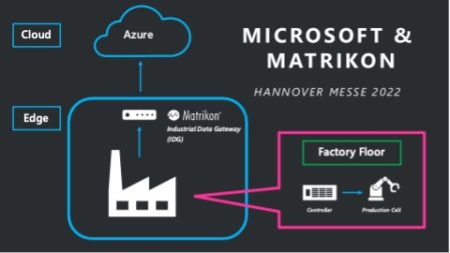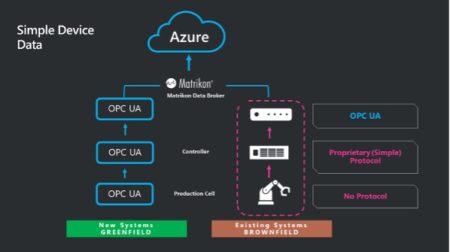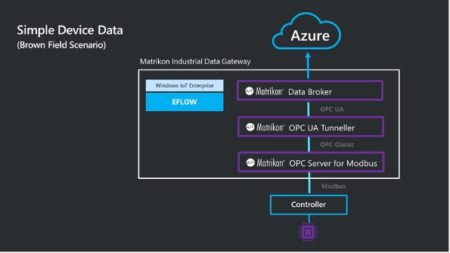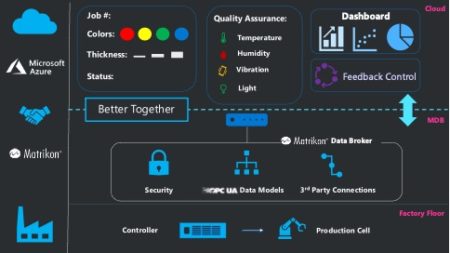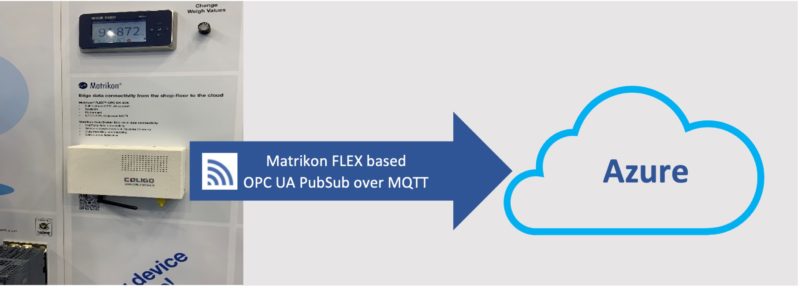SPONSORED BY: MATRIKON
Matrikon Data Broker 2.0 Released
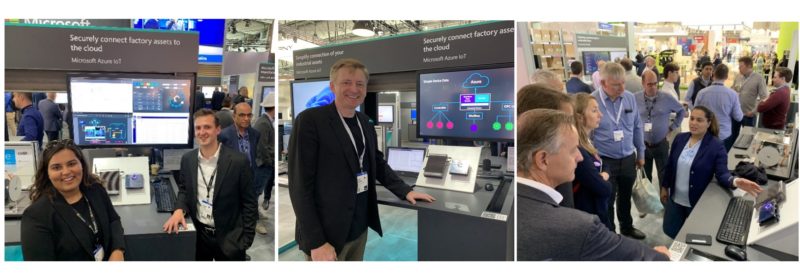
Left: Riddhi Ameser (Microsoft Windows IoT Product Manager) and Francisco Cabrera (EFLOW product manager) are running the joint Matrikon and Microsoft demo. Center: Darek Kominek (Matrikon Marketing Director) Right: Visitors watching the Matrikon Data Broker 2.0 and Azure demonstration at the 2022 Hannover Messe.
Pragmatic Data Modeling for End-Users
Matrikon Data Broker (MDB) 2.0 debuted at the 2022 Hannover Fair. MDB 2.0 makes Data Modeling and Data Mapping accessible for end-users via an easy-to-use graphical user interface. Based on OPC UA Information modeling, MDB users can load OPC UA companion specifications (CS) by simply dragging and dropping them into the application. Once the CSs are loaded, users can instantiate the newly imported types and map values to them from any of the data sources they federated via MDB or other data model instances already present in MDB.
Put UA Companion Specifications to work
Users can take advantage of all valid companion specifications created by OPC Foundation joint working groups, such as the various VDMA working groups, MTConnect, MDIS, and others. In addition, users can also import their own companion specifications that express information models custom created for their project or context. Users can use their favorite 3rd party OPC UA modelers to build the models.
Breathe new life into existing assets
End-users with 3rd party control automation components that do not provide context with their data can now upgrade those assets’ data ‘in-place’ by first federating the components into MDB and then mapping their raw data to instances of information models imported from companion specifications. Connecting simple data from underlying data sources into homogeneous, context-rich models enable the rest of the organization, be it on the OT or IT side, to work with the more useful context directly.
A shop-floor to cloud demonstration at HMI
Using MDB to federate data sources from a production cell composed of Modbus controllers and sensors enables users to map the data from those sources into a joint “production cell” type. This allows users to work with all the relevant cell data (plus extra context introduced by the OPC UA model) via a single production cell instance while eliminating the need for direct connections to the data sources. Collecting and abstracting underlying data sources enables users to directly refer to and work with the relevant production cell data. This reduces human error, especially when new people need to work with the system. Such data modeling and mapping also make the data more easily used for big-data-type projects involving artificial intelligence and machine learning.
Joint Matrikon and Microsoft Demonstration at Hannover Fair 2022 at the Microsoft Pavilion
To demonstrate the power of MDB federation, network traversal, modeling, and mapping – Matrikon teamed up with the Microsoft Azure IoT and Microsoft Windows IoT teams to demonstrate how data from a simulated Modbus-based additive printer (running on a Raspberry Pi) could be securely monitored and controlled from the Azure cloud.
The demonstration purposefully used a simple LED ring paired with a Raspberry Pi to represent simple shop-floor equipment. Matrikon Data Broker 2.0 ran on an Intel Atom-based Matrikon Industrial Data Gateway running Windows IoT OS and Azure IoT Edge for Linux on Windows (EFLOW).
The simple device highlighted how even the simplest legacy systems could take part in the digitalization of the plant via MDB. MDB was used to read in a custom CS that defined information models for an overall Production Cell, a printer, and a 3rd party sensor. Once this hierarchy was instantiated, Modbus registers from the underlying equipment were mapped to it. This allowed the applications running on Azure to interact with the hardware via the Production Cell OPC UA model instead of Modbus registers.
Matrikon FLEX™ v5 – Supports OPC UA PubSub over MQTT
Matrikon FLEX enables developers to easily add OPC UA PubSub over MQTT data sharing out of the box. With UA PubSub over MQTT built into the standard FLEX SDK, applications can simultaneously support the OPC UA client-server and PubSub architectures with minimal development effort.
Implementation Demonstrated at Hannover Fair 2022
The FLEX SDK’s OPC UA PubSub over MQTT functionality was demonstrated on a COLIGO Edge device (www.coligo-tech.com) on the OPC Foundation wall at the 2022 Hannover Messe. Developed by BE.services within a few days, the FLEX-based UA PubSub over MQTT publisher streamed real-time temperature, acceleration, noise level, and other readings from Bosch Connected XDK wireless sensors directly to the Azure cloud. In turn, those values were displayed on a web-based graph.
At the same time, the sensor data from the COLIGO Data Technology Manager was also made available via an OPC UA Server that was accessed ‘on-prem’ at the Matrikon station.
Essential Industrial IoT Functionality
OPC UA PubSub over MQTT is well suited for one-to-many and many-to-one communications commonly found in Industrial Internet of Things (IIoT) solutions. Products that implement OPC UA PubSub over MQTT functionality are an excellent option for securely sharing shopfloor data across the enterprise and with cloud-based applications. Use Matrikon FLEX v5 to implement this functionality in your application today!
To learn more about Matrikon FLEX, visit www.matrikonflex.com
Windows DCOM Security Update
OPC Classic users are encouraged to review the phased DCOM Security changes Microsoft will finalize in 2023 2022. With the final release pushed back by a year, now is the time to prepare.
Those using OPC Classic-based architectures or a hybrid of OPC UA and OPC Classic may be affected because OPC Classic relies on the Windows operating system for its underlying communications via COM and DCOM. Changes to how Windows implements DCOM security can adversely affect OPC Classic communications.
Learn what you need to know about the coming change in the Matrikon whitepaper “OPC Classic Data Connectivity Notice: 2022 Microsoft Windows DCOM Security Update Impact and Path Forward”.
Topics covered in this paper include:
- What this DCOM security update entails and the Windows versions it applies to
- Which OPC Classic architectures will be impacted
- How to solve or mitigate the effects of this update on affected OPC Classic architectures
